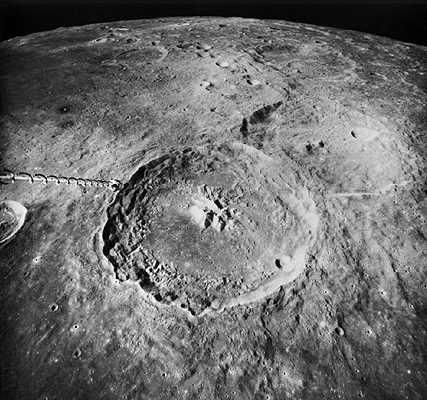February 1, 2015
Theophilus
Originally published February 1, 2004
Image Credit: Apollo 16 (AS16-0692) |
|
Theophilus If Copernicus is the king of lunar craters, Theophilus is at least a duke, if not a prince. Theophilus is a 100 km wide, 4.4 km deep complex impact crater. This oblique Apollo 16 view clearly shows the trademark features of a complex crater: terraced walls, flat floor, and massive central peaks. Because its secondary craters and rays are less well preserved than those at Copernicus, Theophilus must be older. Don Wilhelms, a retired US Geologic Survey lunar expert, has classified Theophilus as Erastothenian in relative age - that is, somewhere between 1.1 and 3.2 billion years old. Its faint rays - can you see them at full Moon? - suggest that Theophilus is at the young end of that range. Finally, note the two dark halo craters to the middle left. These appear to be normal small impact pits that have excavated buried mare material from under the bright ejecta of Theophilus. Related Links: Tomorrow's LPOD: Brightness at Noon |
|
Author & Editor: Technical Consultant: A service of: |
COMMENTS?
Register, and click on the Discussion tab at the top of the page.
You can support LPOD when you buy any book from Amazon thru LPOD!
Contributions to http://www2.lpod.org/ are licensed under a Creative Commons Attribution No-Derivative-Works Non-Commercial 3.0 License. 




